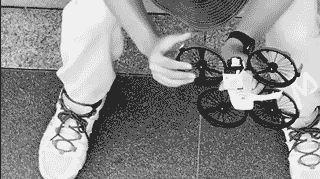
When it comes to leading consumer drone company DJI, there is one product category the company has steered clear of for a while – drones beneath 249g. Recent apparent leaks – from reliable sources – suggest that is about to change, and dramatically so, with a new product line: the DJI Neo.
We have two bits of evidence to go on – a black-and-white video posted on the feed on @OsitaLV's X/Twitter, followed by a number of different postings with a name an specifications. The video appears to show a drone with built-in propellor guards being tested; that's a departure from the design of other DJI drones, slightly more in line with lighter 'toy' drones, but it also appears to have a more DJI-like camera gimbal.
Spark back to life in a Mavic form? pic.twitter.com/V9B19qb5R2July 25, 2024
The name DJI Neo, not to mention specifications, would seem to come from this sticker which is also seen on @DroneXL's feed – another poster that has shown DJI products before their arrival in the past. The sticker design has also been posted on @OsitaLV's feed, featuring CE & UKCA marks, and it notes that the drone will use global positioning satellites to determine the appropriate supported frequency bands to operate in.
According to recent FCC filings, DJI is developing a new drone called the DJI Neo. This compact unmanned aircraft could potentially revolut... - #drone #drones #Brinc #DJIAir3 #DJIAvata #DroneTechnology #Drones #FCCFiling #FirstResponders #Skydiohttps://t.co/qVkMyPvVh9July 26, 2024
The battery specification is the key to working out the weight. At 1435mAh and 7.3V the rumor we can expect a drone around 125-160g. That would be more than the weight of the HoverAir X1 (which also incorporates propellor guards into the design). That drone has 1050mAh batteries at 7.7V.
The DJI Mini series drones, like the DJI Mini 4K, which are 249g, use 2250 mAh batteries, but can remain aloft for nearly half an hour in real-world conditions.
While the HoverAir X1 can remain aloft for about seven minutes in my review tests, a bigger battery and more traditional design might push the possible DJI Neo at least over 15 minutes. The HoverAir X1 also manages to cram an impressive amount of AI subject tracking, and – given DJI's experience and the standard set by the X1 – that is something we can expect here too.
The other question would be control – is this a DJI Spark for a new generation, with a 'real' remote control, or is this more like the HoverAir X1 or the Tello drone (a Wi-Fi phone-controlled drone with DJI tech which is now set to disappear).
The presence of GNSS (or GPS as some might choose to think of it) and the more DJI-like styling in the video suggest we're looking at a new beginners drone in the DJI vein, rather than a replacement for either of DJI's legacy products, but indoor flight is certainly a possibility. There is certainly likely to be a shake-up of our best beginner drone guide.
One somewhat wild bit of speculation I've seen is that autonomous flight will be part of the package. That feels less likely to me. While I don't doubt that the hardware will be theoretically capable, DJI's style with software has generally to keep the lighter, smaller aircraft very much under the user's control, with advanced remote operations for the more serious products (which, one assumes, have more legally-aware operators).
Either way, if true, this has the potential to be a very exciting new product.







